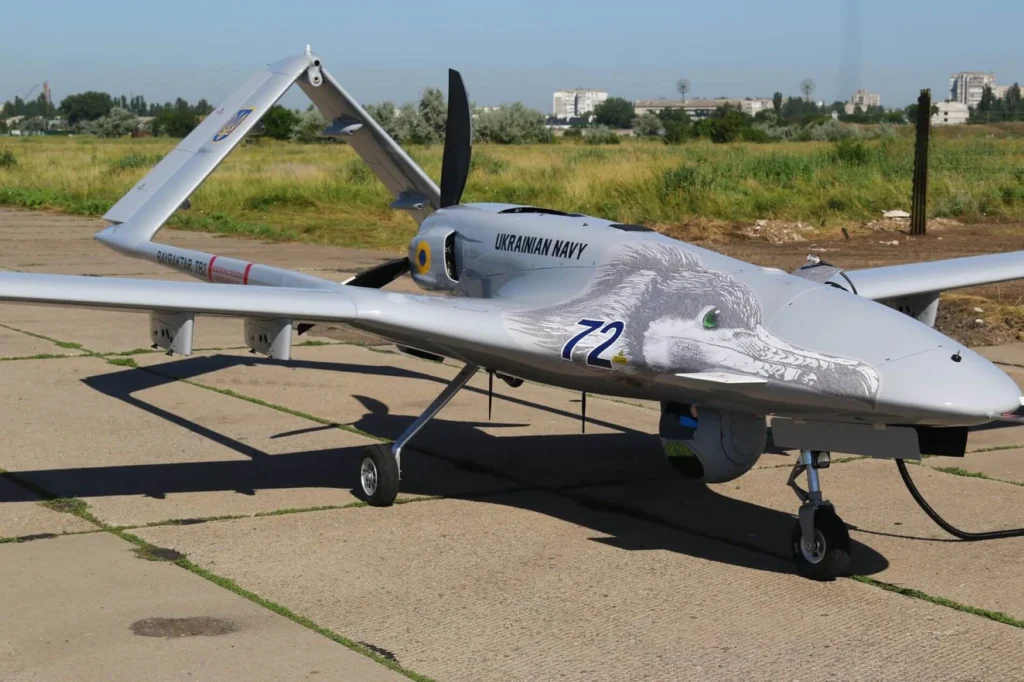The first Bayraktar appeared in the Sumy region, and it has already struck at the columns of Russian equipment and destroyed hundreds of units, said the head of the Sumy Regional Military Administration, Dmytro Zhyvytskyi, summing up the situation for February 28, in a video report on Facebook.
“We have the first Bayraktar in the region, which has already struck at the columns of Russian equipment and destroyed hundreds of units. The first such example was the destruction of about 100 tanks, about 20 Grads, fuel trucks and armoured vehicles … We are waiting for a few more Bayraktars in our region; we are also waiting for European convoys with protection for our soldiers: walkie-talkies, thermal imagers,” said the head of the Sumy OVA.
Earlier, Ukrainian air force Chief Lt. Gen. Mykola Oleshchuk posted a video on Facebook in which he called the Bayraktar TB2 drones “life-giving.”
In the past few days, Ukraine has reported using Bayraktar TB2 drones in the town of Chornobaivka in southern Ukraine and the capital Kyiv.
Russia shoots down 6 Bayraktar TB2 drones
On February 24, Igor Konashenkov, the official representative of the Ministry of Defense of the Russian Federation, said that Russian forces had shot down four Bayraktar TB-2 attack unmanned aerial vehicles of the armed forces of Ukraine.
The militia fighting in Donbas claimed that they had downed two Bayraktar drones on the same day.
Bayraktar TB2 Drones
Bayraktar TB2 is a Turkish strike, tactical and a medium-altitude UAV. Bayraktar TB2 with four missiles on the suspension can be in the air for 12 to 24 hours. The maximum range is up to 150 km. It allows the operator to maintain constant watch in the air and, after identifying targets, quickly advance to the front line to launch missiles. TB2’s reaction time is much less than that of fighter planes, allowing one to effectively hit targets that are only available for a short time. A private company “Baykar Makina” makes the drones.
It was reported that in 2019 Ukraine purchased Bayraktar drones for its armed forces, equipped with Turkish Roketsan MAM-L precision bombs. According to open sources, the contract amounted to $69 million. The Ukrainian customer was supposed to be supplied with six UAVs, two control stations, 200 missiles, and spare parts.

In July 2021, the Ukrainian Defence Ministry announced that the first Bayraktar TB2 for the Navy had been delivered to Ukraine.
The commander-in-chief of the Ukrainian Army, Valeriy Zaluzny, announced last year that they had 12 TB2s in their inventory.
In October 2020, Ukraine announced that it was considering the purchase or joint assembly of 48 more drones. The contract was signed in September 2021.
Ukraine’s Bayraktar use
On October 26 last year, the Armed Forces of Ukraine (AFU), for the first time, used the combat reconnaissance and strike drone Bayraktar in the area of the Joint Forces Operation (JFO) in the Donbas. It was reported that the drone destroyed a militia D-30 howitzer near the demarcation line in Donbas. This had angered Russia, and a harsh response was being anticipated.
The Russian President’s press secretary, Dmitry Peskov, had said that Moscow’s fears were ” confirmed” and that the availability of such weapons to Ukraine could ” potentially lead to destabilization of the situation on the demarcation line.”
A few days after the Bayraktar strike, information began pouring in about a build-up of Russian troops near the Ukrainian border. Later, Russia demanded the West for “security guarantees”, including Ukraine’s non-participation in NATO.
Who else has them, and who has used them?
Bayraktar TB2 drones offer nations a covert air force at a fraction of the cost of maintaining a traditional air force. They have figured prominently in the conflicts in Libya and Syria, but it is perhaps their use by Azerbaijan in 2020 against Armenia that served as an inspirational model for Ukraine.
During the 44 days of fighting for the breakaway enclave of Nagorno-Karabakh, drones had targeted Armenian and Nagorno-Karabakh soldiers and destroyed tanks, artillery and air defense systems. In more than three decades of conflict, they had tipped the scales in favour of Azerbaijan, which has reclaimed part of the territory in a ceasefire agreement with Armenia.
However, TB2s have never encountered an integrated air defense system like the one in Russia.
Turkey has received 107 Bayraktar TB2s since 2011. In 2017, 6 TB2 drones with three control stations were delivered to Qatar. The delivery was completed in November 2019. Poland ordered 24 drones. The first batch is to be delivered in 2022.
